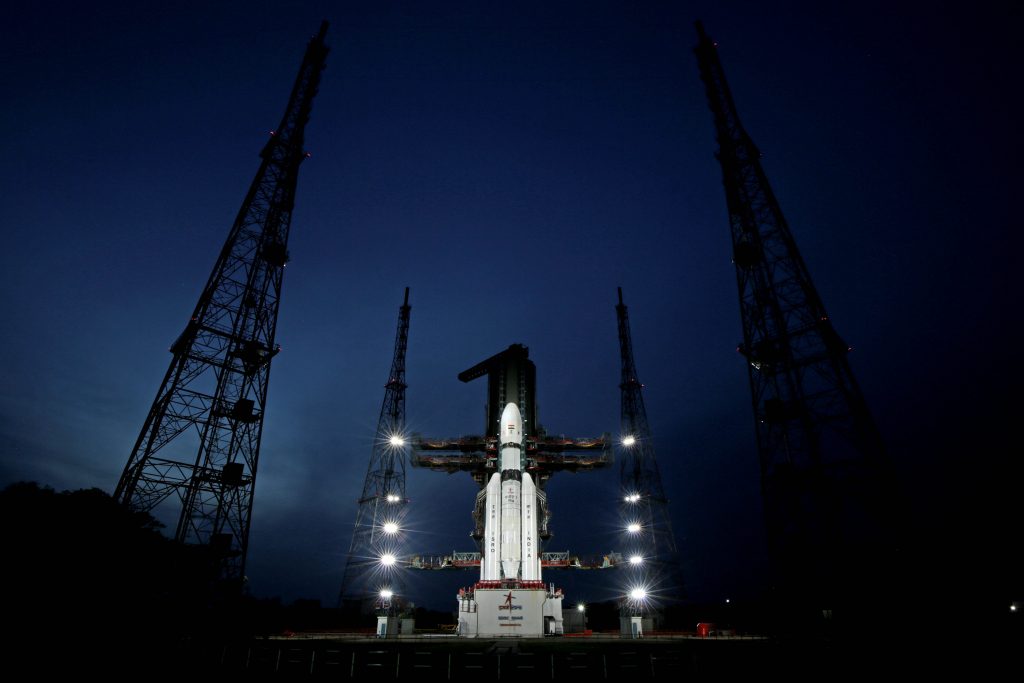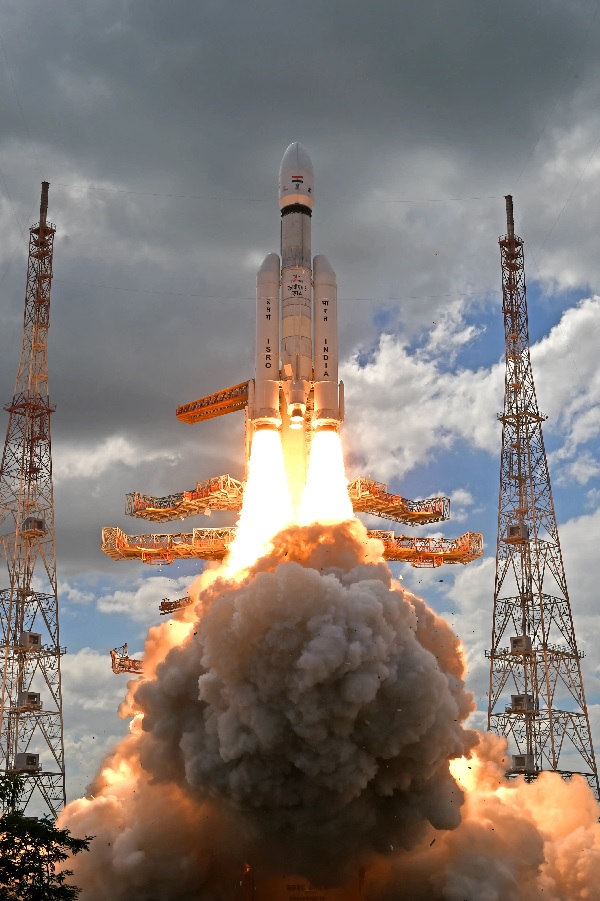Chandrayaan-3: How is India Exploring the Moon?
Written by Sthitee Mohanty, senior writer
If Chandrayaan 3 lands successfully on the moon’s surface, India will become the fourth country to land safely on the moon, joining China, the U.S.A., and Russia
Written by Sthitee Mohanty, senior writer
Chandrayaan 3, India’s rocket to the moon, took off on July 14, 2023, and is now on its way to the moon. It was a big moment for India.
If you are looking for information about Chandrayaan, you’ll find it all here.
Read on to learn about Chandrayaan 3 and India’s mission to the moon.
Key Highlights of the Chandrayaan 3 mission
- Chandrayaan 3 launched successfully at 2:35 pm IST on 14 July 2023 from Sriharikota, India
- Chandrayaan landed on the moon on August 23 2023, with Vikram Lander and Pragyan Rover
- Chandrayaan 3 is a follow-up mission to Chandrayaan 2, both being a part of ISRO’s Chandrayaan programmer
- Expected to collect data from the lunar surface and perform further experiments on the surface
- If Chandrayaan 3 lands successfully on the moon’s surface, India will become the fourth country to land safely on the moon, joining China, the U.S.A., and Russia
What is Chandrayaan 3

Chandrayaan-3 is India’s third mission to the moon – sent by the Indian Space Research Organisation.
It consists of a lander and the Pragyan rover like the one in Chandrayaan-2,. However, this one does not have an orbiter.
Chandrayaan 3 Launch Date and Details

It was launched by the Indian Space Research Organisation (ISRO), India’s space agency, from the Satish Dhawan Space Centre in Sriharikota in Andhra Pradesh, on July 14, 2023. The time of launch was 2:35 pm IST.
Chandrayaan 3 is expected to land on the moon on 23 August 2023, nearly 40 days after its launch date
The aim of this mission is to conduct on-site scientific experiments on the moon.
What Technology Does Chandrayaan 3 Have?

This spacecraft is a lander-rover configuration.
Landers are spacecraft designed to land on the surface of a planet/moon. Rovers are spacecraft created for space exploration, that land on planets with the help of landers and collect scientific data by moving around on the celestial body’s surface.
Chandrayaan 3 has the Vikram lander and the Pragyan rover.

It was launched by an LVM3 rocket from Sriharikota and entered an orbit 100 kilometers from the lunar orbit. Launch Vehicle Mark-III (LVM3) is a three-stage launch device developed by ISRO. It is used to launch spacecraft for lower-range orbits like the geostationary orbit.
Chandrayaan 3 can measure temperature conditions, lunar earthquakes, and plasma density, and can use lasers too! Its propulsion module has a dual function, including both propulsion and communication.
The lander-rover combination has scientific payloads to carry out specific experiments on the surface of the moon.
Did you know that a spacecraft’s payload is a collection of devices that help it carry out its mission in space without any direct human intervention?
About the Chandrayaan Program

The Chandrayaan program is ISRO’s lunar exploration multi-mission program.
Announced on 15 August 2003 by the then Prime Minister Atal Bihari Vajpayee, the program started with the launch of its first phase, Chandrayaan I on 22 October 2008.
Till now, three missions have been launched under the Chandrayaan program: Chandrayaan I, Chandrayaan II, and Chandrayaan III.
Chandrayaan 3 is India’s third lunar mission and a second attempt at making a soft landing on the moon’s surface.
This was launched after the Chandrayaan 2, which failed to land on the lunar surface due to technical difficulties including the loss of the lander. ISRO aims to demonstrate Chandrayaan-3’s safe landing and rover exploration capabilities on the moon’s surface as a follow-up to its previous lunar missions.
| Mission Name | Date of Launch |
| Chandrayaan I | 22 October 2008 |
| Chandrayaan II | 22 July 2019 |
| Chandrayaan III | 14 July 2023 |
What did Chandrayaan 1 Discover on the Moon?

Chandrayaan 1 discovered water molecules on the moon’s surface. With a mission life of 2 years, the mission was concluded on August 29 2009 after the loss of all communication with the spacecraft.
While orbiting the Moon at a height of 100 kilometers from the lunar surface, the spacecraft collected chemical, mineralogical, and photo-geological data from the moon.
Did you know that the spacecraft had instruments from India, the USA, the UK, Germany, Sweden, and Bulgaria?
What About Chandrayaan 2?
ISRO developed Chandrayaan 2 to study the physical differences on the lunar surface and collect more information about water on the moon.
The second lunar mission, with a lunar orbiter, lander, and rover, was supposed to land on the moon to continue further lunar surface explorations but failed to do so. The spacecraft crashed on the lunar surface due to a software glitch that caused its deviation from its planned trajectory. The spacecraft had been attempting to land on 6 September 2019.
If Chandrayaan 3 lands on the moon successfully, India will join the U.S.A., China, and Russia as the fourth country to land an exploratory rover safely on the moon’s surface.
With an almost seventy years old space program, India continues to be ambitious about its space explorations.
Some Significant Space Missions by India
- India launched its first rocket into space in 1963
- Aryabhatta, a satellite wholly designed in India, was launched in 1975
- Remote sensing satellite Bhaskara-I launched in 1979
- With Mangalyaan, India became the first Asian country to reach Mars in 2014
- India launched 104 satellites in one 2017 mission
As India is also a part of the Artemis Accords. ISRO now plans on sending an orbiter to Mars and Venus. It is also planning for an independent space station by 2030.
Why is it important to explore the moon?
Many scientists believe that studying the Earth’s moon can help scientists arrive at answers regarding the Earth’s origin.
NASA has outlined six lunar exploration objectives
- Exploring for future human settlement plans
- Exploring for scientific knowledge on the Earth’s origin, and the origin of life in the universe
- Exploring for future space explorations by making the moon a launchpad for missions to Mars etc
- Exploring global partnerships
- Exploring for economic resources that can be retrieved by lunar mining
- Exploring for public engagement with space and the universe beyond Earth
So how do you explore the Moon?
Here are some different methods of exploring the moon:
| Type | Description | Function | Examples |
| Flybys | Spacecraft goes near the moon but does not enter orbit | Studies the moon from a distance or has a different end destination | Pioneer 4 of the U.S.A, Luna 3 of erstwhile U.S.S.R |
| Orbiters | Spacecraft that enters the moon’s orbit | Carries out prolonged studies of the moon’s surface and atmosphere | Lunar Reconnaissance Orbiter of the U.S.A, Chandrayaan of India |
| Impact Orbiters | One main spacecraft continues to orbit around the moon while one or more devices makes uncontrolled landing on Moon’s surface | Collect data while orbiting and in the process of uncontrolled landing | Luna 2 of the erstwhile U.S.S.R, the Moon Impact Probe of Chandrayaan 1 of India |
| Landers | Soft landing on the surface of the moon | Explore the moon’s surface to collect data and perform scientific experiments | Surveyor 1 of the U.S.A, Apollo Lunar Module of the U.S.A. |
What other countries have sent missions to the moon?
Six nations have landed on the moon since 1958, while 70 successful lunar missions have been carried out.
The United States of America and the erstwhile U.S.S.R. have the highest number of lunar missions, with 50 successful missions out of 90 total missions.
Japan joined the space race with its Hiten Orbiter. Soon after, China, India, and the European Space Agency launched their first successful orbital missions to the moon in the 2000s.
As the countries continue to race against each other in the number of successful space missions, we hope that fundamental questions about the moon, the Earth, and the universe will be answered soon.
Who knows, you might be the first Indian astronaut to land on the moon!
What is ISRO?
Headquartered in Bangalore, Karnataka, India, ISRO is the space agency of India. It studies space and related phenomena to arrive at scientific technologies and applications that can better human life.
Formed on 15 August 1969 by scientist Vikram Sarabhai, ISRO comes under the Government of India Department of Space, directly overseen by the Prime Minister of India. Its current chairman is Sreedhara Somanathan.

Better Your Child’s G.K. In 3 Minutes – Get This Free Newsletter
Get fun facts, simple and easy news, quizzes, and lots of other interesting things to read in your mailbox – for free! It’s what we call GK-on-the-go!
I Kid You Not now has a large readership across India and also parts of the world. If you want to write for us, you can submit your story here. You can also apply to become a news anchor. Apply here
You May Also Like
Why is August 23rd Celebrated as National Space Day in India?



Comments